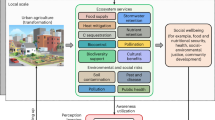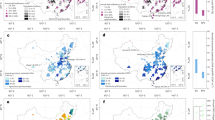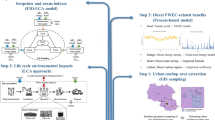Abstract
Urban agriculture (UA) is a widely proposed strategy to make cities and urban food systems more sustainable. Until now, we have lacked a comprehensive assessment of the environmental performance of UA relative to conventional agriculture, and results from earlier studies have been mixed. This is the first large-scale study to resolve this uncertainty across cities and types of UA, employing citizen science at 73 UA sites in Europe and the United States to compare UA products to food from conventional farms. Results reveal that the carbon footprint of food from UA is six times greater than conventional agriculture (420 gCO2e versus 70 gCO2e per serving). However, some UA crops (for example, tomatoes) and sites (for example, 25% of individually managed gardens) outperform conventional agriculture. These exceptions suggest that UA practitioners can reduce their climate impacts by cultivating crops that are typically greenhouse-grown or air-freighted, maintaining UA sites for many years, and leveraging circularity (waste as inputs).
This is a preview of subscription content, access via your institution
Access options
Subscribe to this journal
Receive 12 digital issues and online access to articles
$119.00 per year
only $9.92 per issue
Buy this article
- Purchase on SpringerLink
- Instant access to full article PDF
Prices may be subject to local taxes which are calculated during checkout



Similar content being viewed by others
Data availability
All data used for this study are available in the Supplementary Information. See the attached Supplementary Information for more details and data. Public datasets, including FPED, FICRCD and FNDDS, are available for download online via their citations. EcoInvent data used for lifecycle impact assessment are proprietary and may be accessed via purchase.
Code availability
All code used for this study is available in the Supplementary Information.
Change history
21 March 2024
A Correction to this paper has been published: https://doi.org/10.1038/s44284-024-00066-0
06 February 2024
A Correction to this paper has been published: https://doi.org/10.1038/s44284-024-00044-6
References
Dorr, E., Goldstein, B. P., Horvath, A. & Aubry, C. & Gabrielle, B. Environmental impacts and resource use of urban agriculture: a systematic review and meta-analysis. Environ. Res. Lett. 16, 093002 (2021).
Cohen, N. & Wijsman, K. Urban agriculture as green infrastructure. Urban Agr. Mag. 27, 16–19 (2014).
Goldstein, B., Hauschild, M. Z., Fernández, J. E. & Birkved, M. Contributions of local farming to urban sustainability in the northeast United States. Environ. Sci. Technol. 51, 7340–7349 (2017).
Sanyé-Mengual, E., Oliver-Solà, J., Montero, J. I. & Rieradevall, J. An environmental and economic life cycle assessment of rooftop greenhouse (RTG) implementation in Barcelona, Spain. Assessing new forms of urban agriculture from the greenhouse structure to the final product level. Int. J. Life Cycle Assess. 20, 350–366 (2015).
Kulak, M., Graves, A. & Chatterton, J. Reducing greenhouse gas emissions with urban agriculture: a Life Cycle Assessment perspective. Landsc. Urban Plan. 111, 68–78 (2013).
Pérez-Neira, D. & Grollmus-Venegas, A. Life-cycle energy assessment and carbon footprint of peri-urban horticulture. A comparative case study of local food systems in Spain. Landsc. Urban Plan. 172, 60–68 (2018).
Appolloni, E. et al. The global rise of urban rooftop agriculture: a review of worldwide cases. J. Clean. Prod. 296, 126556 (2021).
Cameron, R. W. F. et al. The domestic garden—its contribution to urban green infrastructure. Urban For. Urban Green. 11, 129–137 (2012).
Dorr, E. et al. Food production and resource use of urban farms and gardens: a five-country study. Agron. Sustain. Dev. 43, 18 (2023).
Orsini, F. et al. Exploring the production capacity of rooftop gardens (RTGs) in urban agriculture: the potential impact on food and nutrition security, biodiversity and other ecosystem services in the city of Bologna. Food Sec. 6, 781–792 (2014).
Whittinghill, L. & Sarr, S. Practices and barriers to sustainable urban agriculture: a case study of Louisville, Kentucky. Urban Sci. 5, 92 (2021).
Martellozzo, F. et al. Urban agriculture: a global analysis of the space constraint to meet urban vegetable demand. Environ. Res. Lett. 9, 064025 (2014).
Haberman, D. et al. The potential of urban agriculture in Montréal: a quantitative assessment. ISPRS Int. J. Geo-Inf. 3, 1101–1117 (2014).
Caputo, S. Applying the Food-Energy-Water Nexus approach to urban agriculture: from FEW to FEWP (Food-Energy-Water-People).Urban For. Urban Green 58, 126934 (2021).
Pocock, M. J. O., Chapman, D. S., Sheppard, L. J. & Roy, H. E. Choosing and Using Citizen Science: a Guide to When and How to Use Citizen Science to Monitor Biodiversity and the Environment (NERC, 2014).
Clune, S., Crossin, E. & Verghese, K. Systematic review of greenhouse gas emissions for different fresh food categories. J. Clean. Prod. 140, 766–783 (2017).
Theurl, M. C., Haberl, H., Erb, K.-H. & Lindenthal, T. Contrasted greenhouse gas emissions from local versus long-range tomato production. Agron. Sustain. Dev. 34, 593–602 (2014).
Urbano, B., Barquero, M. & González-Andrés, F. The environmental impact of fresh tomatoes consumed in cities: a comparative LCA of long-distance transportation and local production. Sci. Hortic. 301, 111126 (2022).
Bell, E., Qin, Y. & Horvath, A. Optimal allocation of tomato supply to minimize greenhouse gas emissions in major US metropolitan markets. Resour. Conserv. Recycl. 188, 106660 (2023).
Stoessel, F., Juraske, R., Pfister, S. & Hellweg, S. Life cycle inventory and carbon and water FoodPrint of fruits and vegetables: application to a Swiss retailer. Environ. Sci. Technol. 46, 3253–3262 (2012).
Kirby, C. K. et al. Differences in motivations and social impacts across urban agriculture types: case studies in Europe and the US. Landsc. Urban Plan. 212, 104110 (2021).
McCann, E., McClintock, N. & Miewald, C. Mobilizing ‘impermaculture’: temporary urban agriculture and the sustainability fix. Environ. Plan. E Nat. Space 6, 952–975 (2023).
Demailly, K.-E. & Darly, S. Urban agriculture on the move in Paris: the routes of temporary gardening in the neoliberal city. ACME Int. J. Critical Geogr. 16, 332–361 (2017).
Cohen, N. & Reynolds, K. Resource needs for a socially just and sustainable urban agriculture system: lessons from New York City. Renew. Agric. Food Syst. 30, 103–114 (2015).
Lawson, L. The planner in the garden: a historical view into the relationship between planning and community gardens. J. Plan. History 3, 151–176 (2004).
Reynolds, K. & Cohen, N. Beyond the Kale: Urban Agriculture and Social Justice Activism in New York City (Univ. Georgia Press, 2016).
Lovell, S. T. Multifunctional urban agriculture for sustainable land use planning in the United States. Sustainability 2, 2499–2522 (2010).
Hawes, J. K., Gounaridis, D. & Newell, J. P. Does urban agriculture lead to gentrification? Landsc. Urban Plan. 225, 104447 (2022).
Sbicca, J. in The Politics of Land (ed. Bartley, T.) 149–170 (Emerald Publishing, 2019).
McClintock, N. Cultivating (a) sustainability capital: urban agriculture, ecogentrification, and the uneven valorization of social reproduction. Ann. Am. Assoc. Geogr. 108, 579–590 (2018).
Campbell, M. C. & Salus, D. A. Community and conservation land trusts as unlikely partners? The case of Troy Gardens, Madison, Wisconsin. Land Use Policy 20, 169–180 (2003).
Wang, C., Chen, Y., Sun, M. & Wu, J. Potential of technological innovation to reduce the carbon footprint of urban facility agriculture: a food-energy-water-waste nexus perspective. J. Environ. Manag. 339, 117806 (2023).
Rufí-Salís, M. et al. Combining LCA and circularity assessments in complex production systems: the case of urban agriculture. Resour. Conserv. Recycl. 166, 105359 (2021).
Purchase, C. K. et al. Circular economy of construction and demolition waste: a literature review on lessons, challenges and benefits. Materials 15, 76 (2022).
Goldstein, B., Hauschild, M., Fernandez, J. & Birkved, M. Urban versus conventional agriculture, taxonomy of resource profiles: a review. Agron. Sustain. Dev. 36, 9 (2016).
Impact Sanitaire et Environnemental du Compostage Domestique (APESA, OLENTICA, BIO Intelligence Service, 2015); https://librairie.ademe.fr/dechets-economie-circulaire/2470-impact-sanitaire-et-environnemental-du-compostage-domestique.html
Andersen, J. K., Boldrin, A., Christensen, T. H. & Scheutz, C. Home composting as an alternative treatment option for organic household waste in Denmark: an environmental assessment using life cycle assessment-modelling. Waste Manag. 32, 31–40 (2012).
Andersen, J. K., Christensen, T. H. & Scheutz, C. Substitution of peat, fertiliser and manure by compost in hobby gardening: user surveys and case studies. Waste Manag. 30, 2483–2489 (2010).
Martínez-Blanco, J. et al. The use of life cycle assessment for the comparison of biowaste composting at home and full scale. Waste Manag. 30, 983–994 (2010).
Rain Barrel Giveaway Program (New York City Department of Environment Protection); https://www.nyc.gov/site/dep/whats-new/rain-barrel-giveaway-program.page
Graywater (Los Angeles County Department of Public Health); http://www.publichealth.lacounty.gov/eh/business/graywater.htm
Grewal, S. S. & Grewal, P. S. Can cities become self-reliant in food? Cities 29, 1–11 (2012).
Ilieva, R. T. et al. The socio-cultural benefits of urban agriculture: a review of the literature. Land 11, 622 (2022).
Rao, N. et al. Cultivating sustainable and healthy cities: a systematic literature review of the outcomes of urban and peri-urban agriculture. Sustain. Cities Soc. 85, 104063 (2022).
van der Werf, H. M. G., Knudsen, M. T. & Cederberg, C. Towards better representation of organic agriculture in life cycle assessment. Nat. Sustain 3, 419–425 (2020).
Finnveden, G. et al. Recent developments in Life Cycle Assessment. J. Environ. Manag. 91, 1–21 (2009).
Schoen, V., Caputo, S. & Blythe, C. Valuing physical and social output: a rapid assessment of a London community garden. Sustainability 12, 5452 (2020).
Plawecki, R., Pirog, R., Montri, A. & Hamm, M. W. Comparative carbon footprint assessment of winter lettuce production in two climatic zones for Midwestern market. Renew. Agric. Food Syst. 29, 310–318 (2014).
Puigdueta, I., Aguilera, E., Cruz, J. L., Iglesias, A. & Sanz-Cobena, A. Urban agriculture may change food consumption towards low carbon diets. Global Food Security 28, 100507 (2021).
Ermolaev, E., Sundberg, C., Pell, M. & Jönsson, H. Greenhouse gas emissions from home composting in practice. Bioresour. Technol. 151, 174–182 (2014).
Quirós, R. et al. Environmental assessment of two home composts with high and low gaseous emissions of the composting process. Resour. Conserv. Recycl. 90, 9–20 (2014).
Ding, W. et al. Effect of long-term compost and inorganic fertilizer application on background N2O and fertilizer-induced N2O emissions from an intensively cultivated soil. Sci. Total Environ. 465, 115–124 (2013).
Zhu, X., Silva, L. C. R., Doane, T. A., Wu, N. & Horwath, W. R. Quantifying the effects of green waste compost application, water content and nitrogen fertilization on nitrous oxide emissions in 10 agricultural soils. J. Environ. Qual. 42, 912–918 (2013).
Aguilera, E. et al. Greenhouse gas emissions from Mediterranean agriculture: evidence of unbalanced research efforts and knowledge gaps. Global Environ. Change 69, 102319 (2021).
Brown, S. & Beecher, N. Carbon accounting for compost use in urban areas. Compost Sci. Util. 27, 227–239 (2019).
Elliot, T. et al. An expanded framing of ecosystem services is needed for a sustainable urban future. Renew. Sustain. Energy Rev. 162, 112418 (2022).
ISO 14040:2006 Environmental Management – Life Cycle Assessment – Principles and Framework (International Organization for Standardization, 2006); https://www.iso.org/standard/37456.html
Bowman, S. A. et al. Food Intakes Converted to Retail Commodities Databases 2003-2008: Methodology and User Guide (USDA, 2013).
Food Intakes Converted to Retail Commodities Overview (USDA ARS, 2021); https://www.ars.usda.gov/northeast-area/beltsville-md-bhnrc/beltsville-human-nutrition-research-center/food-surveys-research-group/docs/ficrcd-overview/
Food Waste FAQs (USDA); https://www.usda.gov/foodwaste/faqs
Tilman, D., Balzer, C., Hill, J. & Befort, B. L. Global food demand and the sustainable intensification of agriculture. Proc. Natl Acad. Sci. USA 108, 20260–20264 (2011).
Bowman, S. A., Clemens, J., Friday, J. & Moshfegh, A. Food Patterns Equivalents Database 2017–2018: Methodology and User Guide, 119 (USDA ARS, 2020); http://www.ars.usda.gov/nea/bhnrc/fsrg
USDA Food and Nutrient Database for Dietary Studies 2017–2018 (USDA ARS, 2018); http://www.ars.usda.gov/ba/bhnrc/fsrg
Caputo, S. et al. FEW-Meter Final Report https://zenodo.org/record/6558032 (2022).
Goldstein, B., Hauschild, M., Fernández, J. & Birkved, M. Testing the environmental performance of urban agriculture as a food supply in northern climates. J. Clean. Prod. 135, 984–994 (2016).
Krikser, T., Piorr, A., Berges, R. & Opitz, I. Urban agriculture oriented towards self-supply, social and commercial purpose: a typology. Land 5, 28 (2016).
Orsini, F., Kahane, R., Nono-Womdim, R. & Gianquinto, G. Urban agriculture in the developing world: a review. Agron. Sustain. Dev. 33, 695–720 (2013).
Wernet, G. et al. The ecoinvent database version 3 (part I): overview and methodology. Int. J. Life Cycle Assess. 21, 1218–1230 (2016).
R Core Team. R: a Language and Environment for Statistical Computing (R Foundation for Statistical Computing, 2018).
Drewnowski, A. & Fulgoni, V. L. Nutrient density: principles and evaluation tools. Am. J. Clin. Nutr. 99, 1223S–1228S (2014).
Caldeira, C., De Laurentiis, V., Corrado, S., van Holsteijn, F. & Sala, S. Quantification of food waste per product group along the food supply chain in the European Union: a mass flow analysis. Resour. Conserv. Recycl. 149, 479–488 (2019).
Jeswani, H. K., Figueroa-Torres, G. & Azapagic, A. The extent of food waste generation in the UK and its environmental impacts. Sustain. Prod. Consum. 26, 532–547 (2021).
Characterization and Management of Food Loss and Waste in North America 48 (Commission for Environmental Cooperation, 2017).
Burek, J. & Nutter, D. W. Environmental implications of perishables storage and retailing☆. Renew. Sustain. Energy Rev. 133, 110070 (2020).
Acknowledgements
This work was made possible by the enthusiasm, patience and support of the farmers and gardeners who became citizen scientists. We also want to thank our colleagues who contributed their time, energy and insight, including L. Roy, M. Israel and L. Jean-Soro, among others. This Article is based on the FEW-meter project, funded by the ESRC (UK, grant no. ES/S002170/2), BMBF (Germany, grant no. 01LF1801A), ANR (France, grant no. ANR-17-SUGI-0001-01), NSF (USA, Belmont Forum 18929627), the National Science Centre (Poland, grant no. 2017/25/Z/HS4/03048) and the European Union’s Horizon 2020 research and innovation programme (GA no. 730254) under the JPI Urban Europe’s call ‘SUGI FWE Nexus’.
Author information
Authors and Affiliations
Contributions
J.K.H. and B.P.G. provided conceptualization, methodology, formal analysis, data curation, contributed to writing the original draft, provided review and editing, and validation. J.P.N. provided conceptualization, resources, contributed to writing the original draft, provided review and editing, supervision, funding acquisition and project administration. E.D. provided conceptualization, methodology, investigation, data curation, contributed to writing the original draft, and provided review and editing. S.C. provided conceptualization, investigation, resources and review and editing. R.F.-K. provided conceptualization, investigation, resources and review and editing. B.G. provided conceptualization, investigation and review and editing. R.T.I. provided conceptualization, investigation and review and editing. A.F.-L. provided conceptualization, investigation, resources and review and editing. L.P. provided conceptualization, investigation, resources, review and editing, and project administration. V.S. provided conceptualization, investigation and review and editing. K.S. provided conceptualization, investigation, resources, review and editing. N.C. provided conceptualization, investigation, resources and review and editing.
Corresponding author
Ethics declarations
Competing interests
The authors declare no competing interests.
Peer review
Peer review information
Nature Cities thanks Michael Martin and the other, anonymous, reviewer(s) for their contribution to the peer review of this work.
Additional information
Publisher’s note Springer Nature remains neutral with regard to jurisdictional claims in published maps and institutional affiliations.
Supplementary information
Supplementary Information
Supplementary Figs. 1–3, Tables 1–3 and summary of online supplementary materials.
Rights and permissions
Springer Nature or its licensor (e.g. a society or other partner) holds exclusive rights to this article under a publishing agreement with the author(s) or other rightsholder(s); author self-archiving of the accepted manuscript version of this article is solely governed by the terms of such publishing agreement and applicable law.
About this article
Cite this article
Hawes, J.K., Goldstein, B.P., Newell, J.P. et al. Comparing the carbon footprints of urban and conventional agriculture. Nat Cities 1, 164–173 (2024). https://doi.org/10.1038/s44284-023-00023-3
Received:
Accepted:
Published:
Issue Date:
DOI: https://doi.org/10.1038/s44284-023-00023-3
This article is cited by
-
Calculating the effect of intensive use of urban organic waste on soil concentrations of potentially toxic elements in a peri-urban agriculture context in Norway
Environmental Sciences Europe (2024)
-
A classification scheme for urban agriculture combining technical properties with characteristics related to the economic and social sustainability
Agronomy for Sustainable Development (2024)
-
Exploring social handprints on well-being: a methodological framework to assess the contribution of business models in city region food systems
The International Journal of Life Cycle Assessment (2024)



